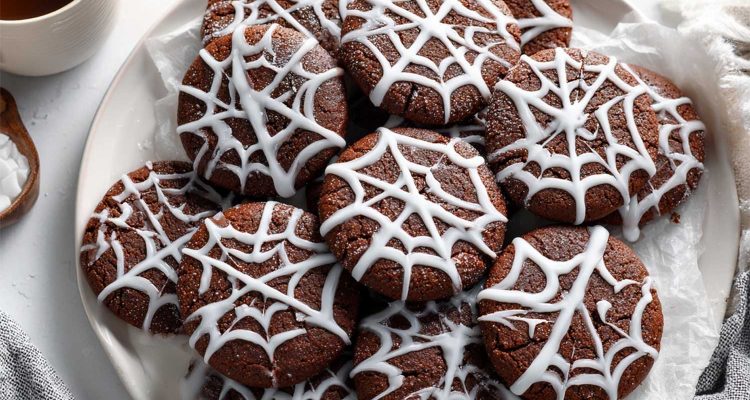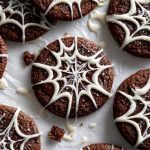Want a Halloween cookie that looks spooky but still fits low-carb life? These keto spiderweb chocolate cookies hit the sweet spot.
They’re chocolatey, not chalky. They hold a shape, don’t crumble in your hand, and take a neat spiderweb design like they were made for it… because well, they were.
The dough mixes fast, chills quick, bakes in minutes, and the glaze sets with a clean bite. You get crisp edges, soft-chewy centers, and that pretty white web on top.
Kids point. Adults “steal just one more.” And you don’t need a pastry diploma or fancy equipment to pull this off.
Below you’ll find clear steps, why each ingredient matters, trick-proof piping tips, storage that actually works, and swaps for dairy-free and nut-free kitchens.
I’ll keep the wording plain and friendly. No fluff. Let’s make cookies that look like they came out of a bakery, not a science lab.
What makes these Keto Halloween spiderweb chocolate cookies the Best
- Almond flour gives body and a cookie bite without wheat. Fine-ground blanched flour is the move. Coarse or “meal” style will give you grainy cookies that spread weird.
- Cocoa powder adds strong chocolate flavor with very few carbs. Dutch-process gives a deeper color and a smoother taste.
- Butter brings flavor and a little spread. It also helps the top get those tiny cracks that make the spiderweb look cooler.
- Egg binds the dough so the cookie doesn’t turn to dust when you pick it up.
- Low-carb sweetener: powdered erythritol/monk fruit blend or powdered allulose. Powdered mixes beat granules for melt-in texture and a clean finish.
- Xanthan gum (just a pinch) keeps the cookie tender and stops crumbling. Skip if your sweetener blend already includes it, but I like the control.
- Baking powder gives a light lift so the cookie isn’t dense.
- Vanilla + pinch of salt make the chocolate pop. Tiny things, big difference.
- Sugar-free glaze (powdered erythritol or allulose with a drop of vanilla) pipes thin lines that set firm enough to stack.
Ingredients (cups and grams)
For the chocolate cookies (makes about 18 cookies):
- 2 cups (224 g) blanched fine almond flour
- 6 tbsp (30 g) Dutch-process cocoa powder
- ¾ cup (120 g) powdered erythritol/monk fruit blend
or ⅔ cup (90 g) powdered allulose (cookies will be softer with allulose) - ½ tsp xanthan gum
- 1 tsp baking powder
- ¼ tsp fine sea salt
- 6 tbsp (85 g) unsalted butter, softened but still cool
- 1 large egg, room temp
- 1½ tsp vanilla extract
- 1–2 tsp almond milk or water, only if the dough looks dry
For the sugar-free glaze (spiderweb):
- ¾ cup (90 g) powdered erythritol (confectioners)
or ⅔ cup (80 g) powdered allulose (glaze will set a touch softer) - 2–3 tbsp almond milk or water, plus more by drops if needed
- ½ tsp vanilla extract
- Pinch of salt (tiny, to round flavor)
Optional add-ins (choose one, small amounts):
- 1 tsp instant espresso powder (boosts chocolate)
- ½ tsp orange zest (Halloween + chocolate = yes)
- ¼ tsp cinnamon or a pinch of chili for a Mexican hot chocolate vibe
Tools you’ll need
- Mixing bowl and a hand mixer (or sturdy whisk and a spatula)
- Baking sheets lined with parchment
- Small cookie scoop (about 1½ tbsp) or a tablespoon
- Piping bag with a small round tip (Wilton #2 or #3)
No piping bag? Use a zip-top bag and snip a tiny corner. - Cooling rack
- Wire whisk for the glaze
- Toothpick or skewer for clean web lines (handy but not required)
Step-by-step: Cookie Dough Recipe
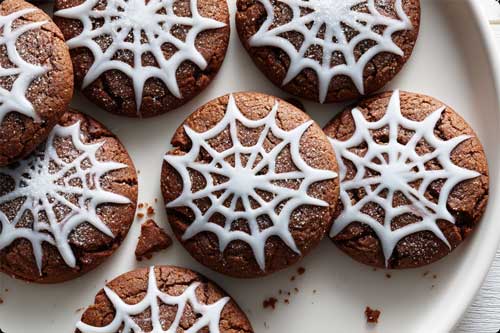
- Mix the dry stuff.
In a bowl, whisk almond flour, cocoa, powdered sweetener, xanthan, baking powder, and salt. Break up every cocoa clump you see. Cocoa hides tiny lumps like a ninja and they show later as dark streaks. - Cream the butter.
In another bowl, beat softened butter for 30–45 seconds until smooth and a little fluffy. Add vanilla and beat again. If using espresso powder or zest, add now. - Add the egg.
Beat in the egg just until combined. Don’t go wild. Over-beating adds air you don’t need and can make the cookies puff then sink. - Bring it together.
Add your dry mix into the butter bowl. Switch to a spatula and fold. The dough should be thick, soft, and a little pliable. If it looks dusty or won’t hold, add 1 tsp almond milk or water, mix, check again. Add the second teaspoon only if it still looks dry. - Chill.
Cover and chill 30 minutes. This lets the almond flour hydrate and keeps the cookie edges neat. If you’re in a rush, 15 minutes in the freezer works.
Shape and bake
- Heat the oven.
Preheat to 350°F (175°C). Line two baking sheets. - Scoop and roll.
Scoop 1½ tbsp dough, roll into balls, and set on the sheet with 2 inches space. You should get 18. - Flatten.
Press gently with your fingertips or the bottom of a glass to about ¼-inch thick. Smooth any cracks around the edges; neat rounds make cleaner webs later. - Bake.
Bake 9–11 minutes, swapping trays halfway. They’re done when the tops look set and the edges look just a tad darker. Don’t wait for a hard feel; almond flour firms up as it cools. - Cool.
Let them rest on the tray 5 minutes, then move to a rack. They should be fully cool before glazing, or the glaze will melt and run.
Make the sugar-free glaze
- Whisk.
In a small bowl, whisk powdered erythritol (or allulose), 2 tbsp milk/water, vanilla, and a tiny pinch of salt until smooth. - Adjust.
You want a pipeable glaze that holds a thin line. Lift the whisk: the ribbon should settle back in about 10–12 seconds. Too thick? Add liquid by drops. Too thin? Whisk in a teaspoon more sweetener. - Bag it.
Spoon into a piping bag fitted with a small round tip. If using a zip bag, push glaze to a corner and snip the tiniest hole you can manage.
Pipe those spiderwebs (the easy method)
- Draw three circles.
On a cooled cookie, pipe a small dot in the center. Then pipe two circles around it, like a dartboard: tiny middle circle, medium ring, then a larger ring near the edge. Keep the lines skinny for a neat look. - Pull the web lines.
Using a clean toothpick, drag from the center dot through the circles to the edge. Think of slicing a tiny pie: drag, wipe the toothpick, rotate the cookie, repeat. Six to eight drags make a classic web.
If you don’t want to use a toothpick, you can pipe the “spokes” directly. The drag method just gives smoother joints. - Let it set.
Leave cookies at room temp until the glaze is dry to the touch. Erythritol glaze sets faster and firmer; allulose takes longer and sets softer. - Optional extra: tiny chocolate spider.
Melt a spoon of sugar-free dark chocolate and pipe a little dot body and a smaller dot head, then eight tiny legs. Cute without adding real carbs.
Timing guide (so you can plan a party tray)
- Mix dough: 10 minutes
- Chill: 30 minutes
- Shape + bake: 12–14 minutes per tray
- Cool fully: 20–30 minutes
- Glaze + set: 20–40 minutes (varies by sweetener and room temp)
Total hands-on time sits around 35–45 minutes. The rest is waiting, which is the hard part.
Taste and texture notes you can actually use
- Crisp edges + soft center come from the butter + almond flour mix and a not-too-long bake. Pull them when they look set but still soft. They firm as they cool.
- Allulose vs erythritol: allulose gives a softer, chewier cookie and a glaze that’s more satiny, but it can brown quicker. Erythritol bakes a touch crisper and sets the glaze like a classic iced cookie. Both keep carbs in check.
- Xanthan gum isn’t for show. It holds the crumb together so you can pipe on top without cracks opening up under the glaze.
Make-ahead, freeze, and store
- Room temp: keep glazed cookies in a single layer in a lidded box up to 3 days. If stacking, place parchment between layers to protect the webs.
- Fridge: keeps them fresh up to 7 days. The glaze may firm even more. Good for early party prep.
- Freeze dough balls: scoop, flatten slightly, freeze on a tray, then store in a bag up to 2 months. Bake from frozen at 350°F (175°C) adding 1–2 minutes.
- Freeze baked cookies (unglazed): cool, layer with parchment, freeze up to 2 months. Thaw at room temp, then pipe the webs so they look fresh and sharp.
Troubleshooting (real fixes, not vague tips)
- Cookies spread too much:
Dough was too warm or had too much liquid. Next round, chill longer and skip extra milk. Measure butter by weight if you can. - Cookies didn’t spread at all:
Butter too cold or sweetener blend too heavy. Flatten the dough a bit more before baking or add ½ tsp more almond milk to the next batch. - Gritty sweetener feel:
You used granulated sweetener. Use powdered, or blitz granules in a blender until fine. - Dry/crumbly cookies:
Over-baked or not enough moisture. Pull them a minute earlier, or add 1 extra tsp almond milk to the dough. Keep the xanthan in—tiny but mighty. - Glaze too runny:
Whisk in more powdered sweetener a teaspoon at a time. Let cookies cool fully before piping. Warm cookies melt glaze every time. - Glaze won’t set:
Too much liquid or very humid room. Move cookies to a cooler, drier spot. Erythritol glaze sets faster than allulose; swap if speed matters. - Web lines look thick and clumsy:
Snip a smaller hole in the bag and thin the glaze slightly. Clean the toothpick between drags so lines don’t smear.
Flavor twists (still low-carb)
- Peppermint chocolate: add ¼ tsp peppermint extract to the dough and another ⅛ tsp to the glaze. Now they taste like a mint thin cookie wearing a costume.
- Orange chocolate: ½ tsp orange zest in the dough, and swap vanilla in the glaze for ⅛ tsp orange extract.
- Mocha: 1–2 tsp instant espresso powder in the dry mix. The chocolate tastes richer, not “coffee flavored.”
- Spicy hot chocolate: pinch of cayenne plus ¼ tsp cinnamon in the dry mix. Warm finish, no heat bomb.
- Black-out webs: use sugar-free white chocolate chips (melted) for the web instead of glaze. Not all chips are equal; pick a brand that lists erythritol or allulose and cocoa butter, not maltitol.
Dairy-free and nut-free options
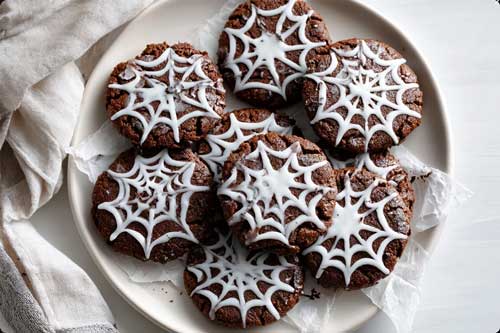
Dairy-free:
Swap butter with refined coconut oil (same grams). Refined version keeps coconut smell out. Add an extra pinch of salt to keep the flavor balanced. Chill the dough well; coconut oil melts quicker.
Nut-free:
Almond flour can be a no-go for some homes. Use sunflower seed flour (same grams) for the closest texture. Heads-up: sunflower + baking powder can turn cookies a bit green from chlorophyll reacting with baking soda traces. It’s harmless and kind of spooky on theme. A splash of lemon juice (½ tsp) in the wet mix reduces the color shift.
Coconut flour route:
You can make a small test batch with coconut flour, but it’s thirsty and not a straight swap. If using coconut flour, you’d need far less flour and more egg. For this exact recipe I don’t suggest it unless you’re very used to coconut flour cookies.
Nutrition snapshot (estimate)
Numbers shift with brands and cookie size, but here’s a realistic ballpark for one cookie out of 18, using almond flour, erythritol blend, and no add-ins:
- Calories: ~130
- Fat: ~11 g
- Protein: ~4 g
- Total carbs: ~7 g
- Fiber: ~3.5 g
- Sugar alcohols: ~2 g
- Net carbs: about 1.5–2 g per cookie
Allulose counts different for many folks since it’s mostly not absorbed. If using allulose, net carbs by most trackers look similar.
Why the spiderweb design is so friendly for beginners
- You’re not drawing perfect lines across a blank canvas. You’re dragging through three circles. The toothpick does the neat work for you.
- Mistakes look like irregular strands. Real webs aren’t perfect either, so you can relax and have fun with it.
- The pattern works on cookies that aren’t perfectly round. A little wobble? The web still reads as a web.
Clean, neat piping without stress
- Keep glaze in a narrow glass to stand the bag upright while you fill it. Less mess.
- Don’t overfill the bag. Half full gives you control.
- Twist the bag top and hold it closed with one hand; guide the tip with the other.
- Practice on a scrap of parchment first. Two lines and one circle, you’re ready.
- If a circle breaks, don’t panic—pipe a tiny dot to connect the gap. The toothpick drag blends it.
Small batch math (for late-night cookie moods)
Want just 9 cookies? Halve everything:
- 1 cup almond flour
- 3 tbsp cocoa
- 6 tbsp powdered erythritol blend (or ⅓ cup allulose)
- ¼ tsp xanthan
- ½ tsp baking powder
- Pinch salt
- 3 tbsp butter
- 1 egg yolk plus 1 tbsp beaten egg white (or use a small egg)
- ¾ tsp vanilla
Bake time stays about the same; start checking at 8 minutes.
Step-by-step recap card (quick reference)
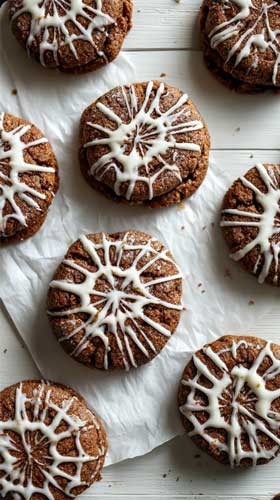
- Whisk dry ingredients.
- Cream butter + vanilla, beat in egg.
- Fold in dry mix; add 1–2 tsp liquid if dry.
- Chill 30 minutes.
- Scoop, flatten, bake 9–11 min at 350°F (175°C).
- Cool completely.
- Whisk glaze to pipeable thickness.
- Pipe three circles; drag outward 6–8 times.
- Dry until set; store.
Tape that on the fridge while you bake. No scrolling with messy hands.
Serving ideas that look fancy with zero extra work
- Cookie board: pile cookies with a few sugar-free dark chocolate squares, roasted nuts, and strawberries. Contrast makes them pop.
- Ice cream sandwich (keto-style): set a scoop of low-carb vanilla between two cookies, freeze 15 minutes. The web becomes the “wow.”
- Party place cards: pipe initials in the center dot before dragging the lines. People love seeing their letter in a web.
Common questions you might think but don’t have to ask
- Do I need a stand mixer? No. A hand mixer or whisk is fine.
- Does the dough have to chill? Yes, for neat edges and good texture.
- Can I double the recipe? Yep. Chill the bowl a touch longer.
- Can I color the glaze? For webs, white is classic. If you want color, use a tiny bit of gel color.
(Okay, not a FAQ section, just getting ahead of the usual panic.)
Ingredient notes and brand tips (plain talk)
- Almond flour: look for “blanched, superfine.” If a package says “almond meal,” pass. Meal = bits of skin = rough cookies.
- Cocoa powder: Dutch-process gives the rich bakery color. Natural cocoa works too; cookies will be a bit lighter and a touch sharper in taste.
- Sweetener: a powdered erythritol/monk fruit blend gives a clean sweet taste. Straight erythritol can cool the tongue a little; the vanilla and salt help. Allulose tastes very close to sugar but softens the cookie. Pick your favorite texture.
- Vanilla: real extract beats imitation. You use so little here that quality shows.
Final little pushes for best results
- Weigh ingredients for the first batch. After that, you’ll know the feel.
- Keep circles thin; the web looks sharper and dries faster.
- Don’t chase a hard feel in the oven. They firm up on the rack.
- Clean hands, clean lines. Wipe the toothpick. Wipe the piping tip now and then.
- Take one photo of the cookie you’re proud of before the plate hits the table. They vanish.
That’s it. You now have keto chocolate cookies that look party-ready, taste like a real treat, and bring that Halloween vibe without a sugar crash. Bake them once and they become a “make-every-October” habit, the good kind.
PrintKeto Spiderweb Chocolate Cookies with Sugar-Free Glaze
Keto chocolate cookies shaped with spiderweb glaze. Soft, chewy, low-carb, sugar-free, and perfect for Halloween or any spooky treat tray.
- Prep Time: 15 minutes + 30 minutes chill
- Cook Time: 10 minutes
- Total Time: 55 minutes
- Yield: 18 cookies 1x
- Category: Dessert, Cookies
- Method: Baking
- Cuisine: American, Keto, Low-Carb
- Diet: Gluten Free
Ingredients
Cookies (about 18)
-
2 cups (224 g) blanched almond flour
-
6 tbsp (30 g) Dutch-process cocoa powder
-
¾ cup (120 g) powdered erythritol/monk fruit blend (or ⅔ cup allulose)
-
½ tsp xanthan gum
-
1 tsp baking powder
-
¼ tsp salt
-
6 tbsp (85 g) butter, softened
-
1 large egg, room temp
-
1½ tsp vanilla extract
-
1–2 tsp almond milk or water, if needed
Glaze
-
¾ cup (90 g) powdered erythritol (or ⅔ cup/80 g powdered allulose)
-
2–3 tbsp almond milk or water
-
½ tsp vanilla extract
-
Pinch of salt
Instructions
-
Whisk almond flour, cocoa, powdered sweetener, xanthan, baking powder, and salt in a bowl.
-
Beat butter until smooth. Add vanilla, then beat in the egg until just combined.
-
Fold dry mix into wet. If dough looks dry, add 1–2 tsp almond milk.
-
Cover and chill 30 minutes. Preheat oven to 350°F (175°C). Line two baking sheets.
-
Scoop 1½ tbsp dough, roll into balls, place 2 inches apart, and flatten to ¼ inch.
-
Bake 9–11 minutes. Cool 5 minutes on tray, then fully on a rack.
-
Make glaze: whisk powdered sweetener, milk, vanilla, and salt until smooth and pipeable.
-
Pipe 3 circles on each cookie, then drag a toothpick outward to form spiderwebs.
-
Let glaze set before storing or serving.
Notes
-
Chill dough so cookies hold shape.
-
Erythritol glaze sets firmer; allulose makes a softer finish.
-
Store at room temp for 3 days, fridge for 7, or freeze unglazed cookies up to 2 months.
-
Net carbs: about 1.5–2 g per cookie.
Nutrition
- Serving Size: 1 cookie
- Calories: 130 Sugar: <1 g Sodium: ~60 mg Fat: ~11 g Saturated Fat: ~4 g Unsaturated Fat: ~6.5 g Trans Fat: 0 g Carbohydrates: ~7 g Fiber: ~3.5 g Protein: ~4 g Cholesterol: ~20 mg
